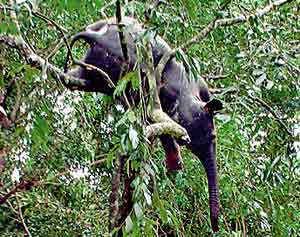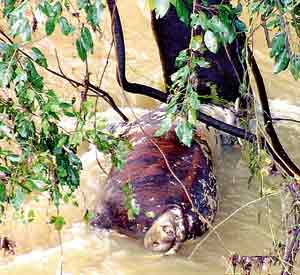Temporary camps have been setup , medicine and dry rations are being supplied continuously for hundreds and thousands of people affected by the floods and heavy rains have wreaked havoc in many parts of the country. But wildlife remains a silent victim in the face of this. The image of a dead elephant calf stuck on top of a tree epitomises that sad ordeal of wild animals in these flooded regions.
The image caught the attention even of the international media to illustrate the severity of the recent floods. The carcass was found on Thursday stuck on a tree about 18 ft high on the bank of the Gal Oya River. This height indicated the level to which water levels had risen ravaging the area. “Elephants are usually good swimmers, but the force of the current would have been too strong for this calf,” said Dr.W.A.Darmakeerthi a veterinary surgeon of the Wildlife Department. The body had later fallen to the river and was washed further downstream according to the veterinarian who expects to conduct a post mortem after the waters recede.
 |
| Sad sight: Baby elephant dead on top of a tree |
 |
| A carcass being swept away by the raging waters Pic by Kanchana Kumara Ariyadasa |
Dr. Pramuditha Devasurendra – another wildlife vet who looks after the Eastern wildlife region highlighted the death of another elephant that may have succumbed to the prevailing wet and cold weather. This elephant in Aranthalawa was already weak as it was suffering from a fractured fore limb. Although the animal had been treated for the fracture it had died a few days later possibly unable to withstand the cold and wet conditions as it was already weak.
However the veterinarian said it was the only reported case from the region regarding elephants. Unlike humans, all animals can swim at least a little distance to reach higher ground. Therefore Wildlife Department officials believe most animals would have survived although the situation regarding wildlife in areas adversely affected by the floods is yet to be assessed. However, ground reports have indicated that a large number of domestic animals like cattle and poultry had died due to the raging waters.
The Flood Plains National Park and Somawathie National Park are among the worst affected. Most of the areas are still submerged and wildlife officers cannot access the parks to assess the situation, Dr.Chandrawansa Pathiraja – the Director General of the Department of Wildlife Conservation (DWC) said. He said there were initial reports that some electrified fences were damaged. However he hopes to get a full report from his officers on the ground situation next week. As the name indicates, parts of the Flood Plains National Park go underwater when the Mahaweli Ganga swells. This process helps to maintain its unique ecosystem, but the damage caused by the torrential rains and flooding are yet unknown.
The roads network in national parks including Yala East (Kumana) too have been badly damaged. This could hamper the administrative work of wildlife officers.
Environmental experts also say that the damaged tanks in these areas could have an adverse affect on wildlife when the next drought grips these areas. Many of the smaller tanks have been damaged by the heavy rainfall and these will not be able to retain sufficient water to support animals in the next severe drought. This may force elephants to move into villages further intensifying the Human Elephant Conflict, they point out.
Meanwhile a Health Ministry spokesperson said the hospitals in flooded areas have been alerted about possible increase of snake bite victims. Snakes like humans will try to move to higher ground to save their lives and may encounter humans. According to the spokesperson, no snake bite victims have been recorded so far, but the ministry has issued instructions to its medical teams to be cautious of snakes and other animals when they travel from camp to camp providing relief to affected people.
There is also a belief venomous sea snakes come inland during a flood, but Dr.Anslem de Silva,a leading herpetologist, who is conducting a research on Sea Snakes says the movement occurs in reverse, only when more land snakes get washed to sea. In December the media also reported thousands of sea snakes in Batticaloa beaches raising fear among residents that it was a sign of an impending disaster, as scenes were witnessed a few months before the 2004 tsunami. Some still say the recent Sea Snake sighting off Batticaloa was a bad omen indicative of the the present devastating floods. But Dr.Anslem who investigated samples of these purported Sea Snakes from Batticaloa says it was only a reproductive gathering of a marine Eel species. |



